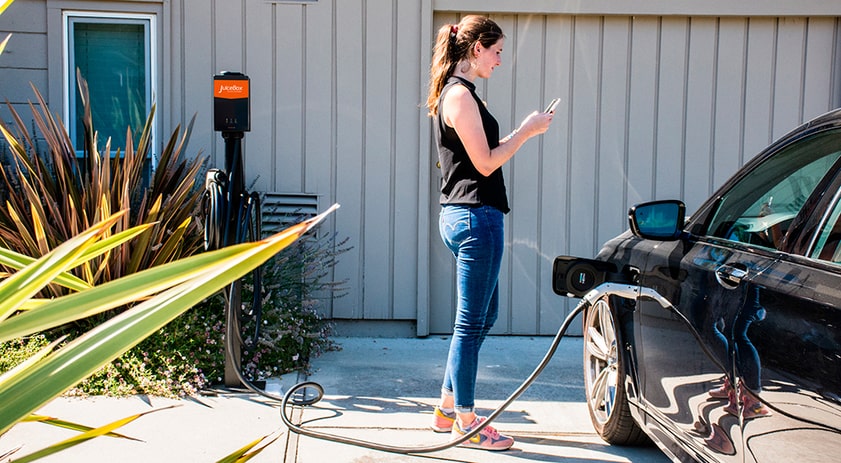Everything You Need to Know About Electric Car Charging At Home

Many new electric car buyers believe that finding charging stations is the most challenging aspect of EV ownership, and that waiting for their car to charge will be an onerous task, because we’ve all been conditioned to refuel our cars by driving to a gas station and waiting there while the car refuels. When it comes to charging electric vehicles, the entire refueling paradigm is different. Charging your EV actually looks a lot more like charging your cell phone or laptop, than it does refueling your gasoline car. Most people plug in their cell phones at night and start out the day with a full electric car battery life. When they have access to charge their phone or laptop at work or elsewhere, they might plug it in to top off the battery.
Electric cars have a similar charging pattern. Studies have shown that as much as 95% of electric vehicle charging is done at home. After home charging, the workplace is the most common place to plug in. So the fear of being able to find charging stations, and then the need to wait for your EV to charge is overblown. That’s because the chargers are located at the places where you already spend the most time, and your EV charges while you’re sleeping or working. The need for public charging is an edge use case for most people, and home charging will continue to be the backbone of EV infrastructure needed to support high EV penetration. That said, public charging supports universal access, and provides convenience and psychological comfort for all other "edge" driving cases. Both are needed and work hand in hand.
And most electric car owners agree, there’s really nothing more convenient than plugging in at home. Electric car charging at home is also a much better experience than filling up at the pump for a number of reasons:
1. No need to go out of your way to drive to a gas station and wait for a pump to be open.
2. You don’t need to touch a dirty gas nozzle.
3. You won’t smell like gasoline for awhile after plugging in.
4. Electricity costs much less than gasoline, making your MPGe much cheaper.
5. It only takes about 10 seconds to grab the connector, open the charge port and plug in.
6. You can leave home with a “full tank” every day with a level 2 JuiceBox smart charger.
Which home charging station is right for you?
Most electric cars today come standard with a portable level 1, 120 volt charger. A level 1 electric vehicle charger will charge it at a rate of roughly 4 to 5 miles per hour. These slow chargers may work fine for plug-in hybrid (PHEV) because they have small batteries and aren’t capable of storing much energy. However, a battery electric car, or BEV, can store more renewable energy than a level 1 charger can replenish overnight. Some large battery BEVs can take as long as three days to fully recharge on a level 1 charger, and that’s just not convenient. Therefore, most BEV owners purchase and install a 240 volt, level 2 charging station for their electric car charging at home.
There are a lot of home EV charger choices available today, so how do you know which one is right for you? Whatever you’re looking to purchase, it’s always a good idea to check and see what the experts say. This recent EV charging station buyers guide answers a lot of the questions that would-be EVSE buyers might have, and selected JuiceBox as its top pick.
Here are some of the important factors to consider when shopping for an EV charging station:
Safety certification: Make sure it’s UL certified to ensure safety. Electric car charging at home is very safe, as long as the equipment you’re using has been thoroughly tested and certified. Some of the less expensive, budget chargers on the market are not UL tested and certified and have very short warranties, because the quality can’t be ensured.
Cable length: Make sure the charging cable is long enough. Some charging stations come with cables as short as only 12 feet long. That may be long enough for charging on most days, but you should consider the future when you may have another EV. Different EVs have different locations for their charging ports. Some are on the front of the car, some on the side and some in the rear. Make sure you get a charging station that has a cable long enough to reach any point of your garage or driveway, for future consideration. For this reason, we recommend a cable that is at least 20 feet in length. Our JuiceBox stations come with cables up to 24 feet.
Power: Future proof your investment with a powerful charging station. While all level 2 charging stations operate on 240 volts, they are offered in a wide range of amperage. Some can only deliver 16 amps, while others can deliver up to 80 amps. Most EVs today can accept at least 30 amps, so we recommend buying a charging station that can deliver at least 32 amps. If you want to really future proof your investment, a 40 amp charging station might be your best choice.
Rated for outdoors: If you’re installing the charging station outdoors, make sure it’s built to withstand extreme weather, so it lasts a long time. Many charging stations that are “outdoor rated” aren’t rated for extreme weather, which we all know happens from time to time. Before buying an electric car home charging station, make sure it’s NEMA-4 rated for extreme weather. Some charging stations are only NEMA-3 rated and can allow water, dust and other elements to enter the enclosure under extreme conditions.
Smart charging: A dumb charger simply supplies power to your car when you plug in. Smart chargers can charge your car just the same, but offer a host of additional benefits. You can schedule the charging times to take advantage of reduced time-of-use electricity rates, view records of past charging sessions and calculate your total electricity use for the car, possibly earn money by participating in demand response programs with your utility, and some fast chargers like the JuiceBox even allow Amazon Alexa and Google Home integration, which makes living the EV life even more convenient.
Installing your electric car home charging station
Once you’ve decided on which home charging station to buy, you need to consider the installation. Every home is different, and every home charging installation has different challenges. In an ideal circumstance, the electric panel is located in the garage, and there’s ample excess capacity to add the dedicated circuit that the charging station needs. However, not all homes have the ideal circumstance, so you need to have a licensed electrician examine your home, and provide you with an estimate for the installation.
Some of the factors involved in home charging installation:
1. Does your home have ample excess capacity to add the necessary dedicated circuit?
2. The location of your electric panel - how far it is from your garage?
3. Are you installing the charging station in your garage or outside?
4. What permits are required from your municipality?
5. Is your home properly grounded?
We understand that the installation can seem a bit overwhelming to some people, so we’re working to make the process as simple as possible for our customers.
How long will my electric car take to charge at home?
Like gasoline cars, electric cars come in all kinds of models and sizes. Like gasoline cars, larger cars typically have larger “fuel tanks” which means a larger battery for an EV. The bigger the battery the longer the car can take to fully recharge. Below are a few factors that determine how long an electric car takes to charge:
1. Battery size: Gasoline cars have fuel tanks that are measured in gallons. Electric cars have batteries and their size is measured in kilowatt-hour, or kWh. For instance, some Teslas have 100 kWh batteries, while some Nissan LEAFs have a 40 kWh battery. Therefore the Tesla can hold more than double the amount of electricity than the LEAF can.
2. Rate of charge: The Tesla can accept up to 48 amps, while the LEAF can only accept 30 amps. This means the Tesla can charge at a faster electric rate if it has a supply that can deliver the full amount the car calls for. Check out our EV charging times table to find out how long it will take you to charge your EV.
3. Electricity supply: As mentioned above, there are low-powered home charging stations on the market that can take very long to charge your EV. It’s wise to consider purchasing one that can deliver at least 30 amps. If you have a larger EV with a big battery, you might want to consider a 40 amp charging station, like our very popular JuiceBox Pro 40, which has been a best selling charger on Amazon for the last 5 years.
A good way to think of how fast your EV will charge is in “miles per hour” of charging. Here’s a good estimate based on the level of power being delivered to the EV:
• Level 1 charging: 3 to 5 miles per hour
• Level 2 charging at 16 amps: 12 to 15 miles per hour
• Level 2 charging at 32 amps: 25 to 30 miles per hour
• Level 2 charging at 40 amps: 30 to 35 miles per hour
What do you need to do to maintain your home EV charger?
Like any electronic device, misuse or abuse will surely lead to a reduced service life. However, there are a few things you can do to make sure you get the most out of your EV smart home charger.
1. Keep the EV charging connector protected. No matter your EV Charging Connector Type, It’s important to make sure you keep your connector or plug clean and dry. It’s fine to charge outside in the rain or snow because while the connector is plugged into your car it has a watertight seal. Once you unplug make sure you plug the connector into a holster that will protect it while it’s not in use. Every JuiceBox charging station comes with a connector holster so you can keep your connector free from moisture, dirt, dust and other elements while it’s not in use.
2. Store the cable where it won’t be frequently run over by cars. Electric vehicle charging stations have robust cables that are tough, and can withstand being run over by cars, but that doesn’t mean it OK to do it frequently. Try not to run over the cable, and make sure you do not park on it. While it’s ok to run over the cable, it’s not ok to park on it leaving the weight of the vehicle on the cable for a prolonged period. This can damage the wires and render the charging station unusable.
3. Unplug during severe lightning storms. While this isn’t necessary, it is recommended by the U.S. Department of Homeland Security, you should unplug all of your appliances because lightning strikes near your home can wreak havoc on any electrical appliance, as the electrical surge from the strike can spike higher than any appliance can withstand. If you have a fast charging station at home like the JuiceBox that can plug in, as opposed to a hard-wired one, you can easily unplug it during severe weather, and eliminate the possibility, albeit small, that lightning can damage the charging unit.
We hope these tips have helped clear up some questions you have about electric car charging at home. If you have any other questions, feel free to contact eMotorWerks customer support, and we’ll be happy to help.



